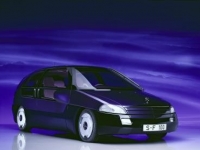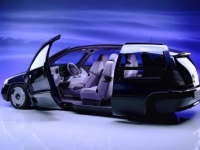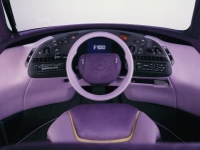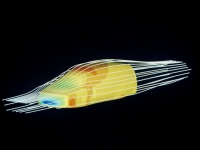Automobiles
Forerunner of the connected car
F 100 research vehicle
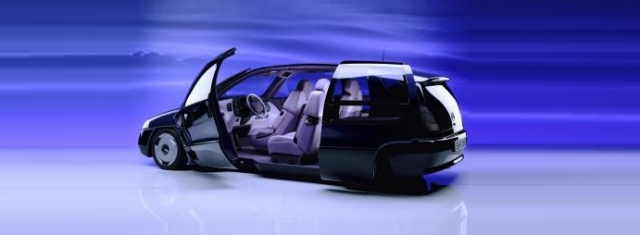
F 100 research vehicle (Source: © 2016 Daimler AG. All rights reserved.)
USPA NEWS -
25 years of the Mercedes-Benz F 100 research vehicle - Forerunner of the connected car: Mercedes-Benz F 100 -
The F 100 research vehicle celebrated its world premiere 25 years ago. Never before had the designers and engineers realised so many new ideas and innovative solutions in a single vehicle.
The F 100 research vehicle celebrated its world premiere 25 years ago. Never before had the designers and engineers realised so many new ideas and innovative solutions in a single vehicle.
At the same time, with all its technology, the vehicle was a forerunner of today's connected car, of which the latest Mercedes-Benz standard-production vehicle is the new E-Class. Mercedes-Benz has a long tradition of demonstrating pioneering technology in visionary and fully functional vehicles: this is a tradition that dates back to Carl Benz's patent motor car from 1886.
Voice-controlled car telephone, autonomous intelligent cruise control, xenon headlamps and a chip card as the vehicle key: even 25 years ago, the Mercedes-Benz F 100 featured many of the systems we today take for granted ““ and not just those. A quarter-century ago, it was a vehicle that gave a fascinating promise of the future of automotive technology. This was due to its innovations in the key areas of passive and active safety, ergonomics and its concept of space. In its subsequent standard-production cars, the Stuttgart-based brand followed up on this promise with some pioneering systems.
In January 1991, Mercedes-Benz unveiled the research vehicle at the NAIAS show in Detroit, thereby establishing an especially exclusive family of models: the F 100 was the first Mercedes-Benz research vehicle to feature an "F" in its name. This tradition was continued by the F 200 Imagination (1996), F 300 Life Jet (1997), F 400 Carving (2002), F 500 Mind (2003), F 600 HYGENIUS (2005), F 700 (2007), F 800 Style (2010), F 125! (2011) and F 015 Luxury in Motion (2015).
The research vehicles include many other vehicles that were built in the brand's 130-year history. Examples are Carl Benz's entirely innovative patent motor car from 1886 as well as the Mercedes-Benz C 111 Wankel-engined sports car (1969), the Mercedes-Benz Vario Research Car (1995), which was designed for maximum versatility, and the Mercedes-Benz bionic car, with which the engineers in 2005 demonstrated the potential of bionics in relation to automobile construction. What all of them had in common was that they were fully functional one-off vehicles featuring new systems and technologies that could be experienced, driven and evaluated.
From research to near-production concept
In addition to its research vehicles, Mercedes-Benz also develops technology vehicles, test vehicles, concept vehicles and one-off vehicles in advance of new standard-production models. Technology vehicles are standard-production vehicles that are equipped with new technology ““ such as alternative drives ““ in order to test that technology under everyday conditions. Related to research vehicles, so-called test vehicles are used to take new technologies out of the research lab and onto the test track.
In addition to its research vehicles, Mercedes-Benz also develops technology vehicles, test vehicles, concept vehicles and one-off vehicles in advance of new standard-production models. Technology vehicles are standard-production vehicles that are equipped with new technology ““ such as alternative drives ““ in order to test that technology under everyday conditions. Related to research vehicles, so-called test vehicles are used to take new technologies out of the research lab and onto the test track.
Concept vehicles are near-production, ready-to-drive vehicles that position a future vehicle model on the market. They are usually equipped with novel technology just short of readiness for use in series production. Finally, one-off vehicles are feasibility studies that show new ideas in the form of complete automobiles. In 1991, the F 100 was clearly a member of the group of visionary research vehicles. It was employed by the engineers and designers to implement key findings in relation to future demands on vehicle technology.
Among other things, the research vehicle incorporated findings from accident/social research: as a typical passenger car carries an average of between 1.2 and 1.7 people in everyday use, the developers positioned the driver in the centre of the passenger cell ““ the safest place inside the vehicle. This made the innovations in terms of crash safety for the driver even more effective. The occupants in the second row were seated to the left and right behind the driver. Two further passengers were given seats towards the centre between the sturdy rear wheelhouses. The body of the F 100 with its steeply raked rear end anticipated the trend of future years, in which there was an increasing demand for spacious estate cars and other vehicles.
The innovative spatial concept of the interior was matched by new-type doors: access to the driver's seat was by means of rotating-swivelling doors, which took parts of the vehicle floor and roof with them when opened. When they were closed, mechanical locking mechanisms in three places ensured firm, reliable closing. In this way, the F 100 made up for the slender waistline in the vehicle floor and the design with no B-pillar between the front doors and the space-saving, rear pivot-and-slide doors.
Herald of the connected car
With many of its systems, the F 100 anticipated solutions that were in future years to give rise to the connected car. These included the voice-controlled telephone system and the central display, on which the vehicle system automatically showed the key information in every situation ““ such as the current speed or warnings about traffic in the area around the vehicle. Such information was delivered, for example, by the reversing camera, the distance-warning radar and a further radar system that monitored the traffic behind the F 100 and warned of vehicles in the blind spot if the driver indicated to change lane. Automatic lane keeping was also possible.
With many of its systems, the F 100 anticipated solutions that were in future years to give rise to the connected car. These included the voice-controlled telephone system and the central display, on which the vehicle system automatically showed the key information in every situation ““ such as the current speed or warnings about traffic in the area around the vehicle. Such information was delivered, for example, by the reversing camera, the distance-warning radar and a further radar system that monitored the traffic behind the F 100 and warned of vehicles in the blind spot if the driver indicated to change lane. Automatic lane keeping was also possible.
Other electronic assistance systems in the F 100 included access to the car by chip card instead of a conventional key, electric motors to control the adjustment of seat and steering wheel, mobile fax and a permanently installed personal computer. The power supply was assisted by solar cells in the roof with an area of almost two square metres and an output of up to 100 watts.
More light
The research vehicle also adopted a new approach to lighting technology: the highly compact headlamps were the first from Mercedes-Benz to use gas-discharge lamps. This technology was later to become known under the name of xenon headlamps. The tail lamps were of transparent prism rods that served as light conductors and were activated from a central light source in the appropriate colour depending on the required function.
The research vehicle also adopted a new approach to lighting technology: the highly compact headlamps were the first from Mercedes-Benz to use gas-discharge lamps. This technology was later to become known under the name of xenon headlamps. The tail lamps were of transparent prism rods that served as light conductors and were activated from a central light source in the appropriate colour depending on the required function.
Another first from Mercedes-Benz was the front-wheel drive of the F 100. The engineers experimented with various engine concepts in the research vehicle, including a modified internal combustion engine that ran on hydrogen. Further innovations included a sandwich floor and electronic tyre pressure monitoring. In the sum of its features and design details, the F 100 represented nothing less than a new type of automobile. Today, 25 years after its premiere, the philosophy behind this research vehicle is more up to date than ever.
Liability for this article lies with the author, who also holds the copyright. Editorial content from USPA may be quoted on other websites as long as the quote comprises no more than 5% of the entire text, is marked as such and the source is named (via hyperlink).

